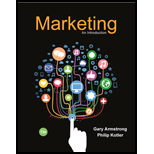
Case summary:
To make sales, goods are needed by the retailers. The biggest asset of the retailer is the inventory. As there is not enough stock of goods that may result in low sales and carrying large inventory, which increases the costs and decreases the margin. These two situations reduce the profit.
The efficiency of the reseller’s inventory management is stock-turn rate (inventory turnover rate for producers). The key to succeed in the retailing business is realizing a heavy quantity of sales on a small inventory as probable while maintaining enough stock to meet the demands of the customer.
Introduction:
Stock turnover is also known as inventory turnover; it is the rate or ratio that shows the number of times the company has sold and replaced stocks in a particular period.
To determine: The stock turn rate of a retailer.
Want to see the full answer?
Check out a sample textbook solution
Chapter 11 Solutions
Marketing: An Introduction (13th Edition)
- Which of these describes a retail store which uses a medium-end strategy? a. Premium items b. Moderate pricing c. High price d. Cheap merchandisearrow_forwardWhich of these describes a retail store which uses a low-end strategy? a. High price b. Well-known brands c. Premium items d. Cheap merchandisearrow_forwardThe type of non-store retailing where sales people interact, information is conveyed and demonstrate merchandise benefits to consumers is a. Television home shopping O b. Internet channel O c. Direct selling O d. Catalog channelarrow_forward
- Which of these factors matters in the definition of what constitutes retailing? Question options: The firm's national tax classification How customers refer to the company Whether the company sells to final consumers Where the goods or services are sold How the goods or services are soldarrow_forwardHow do retailers manage their inventory, and what are some of the techniques they use to control stock levels ?arrow_forwardExplain what a wholesaler does. How does this benefit the retailer? How does this benefit the manufacture?arrow_forward
- The wheel of retailing helps explain the evolution of firms that enter a market on a shoestring budget and gain customers by offering lower prices. It suggests that once a customer base is established, the retailer begins offering higher-end products, more upscale facilities, and better service. ) a) True () b) Falsearrow_forwardMass-merchandisers Multiple Choice face a bright future and increasing profits—because of decreasing competition. offer lower prices to get faster turnover. operate on the "buy low, sell high" philosophy. try to reduce costs by reducing inventory turnover. None of the answers are correct.arrow_forward1.What is your favorite consumer goods retailer? Discuss the criteria you have used in making your selection. What can a competing firm do to lure you away from your favorite firm? Apply your answer to retailing in general. 3. Define the term "total retail experience." Then describe a recent retail situation in which your expectations were surpassed and state why.arrow_forward
- Is a direct selling supply chain without retail stores always less expensive than a supply chain with retail stores?arrow_forwardManufacturers use wholesalers and retailers because they have no other choice. they do not cost much. they do not create value for customers through convenience and cost savings. wholesalers control retailers. none of the above.arrow_forwardHow might the growth in online marketing affect the structure of retail supply chains? Provide and discuss one example of companies who have succeeded and one example of those who have faltered by this growth.arrow_forward
